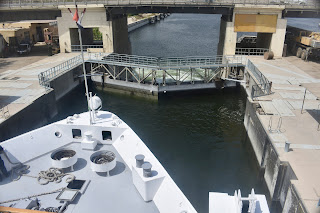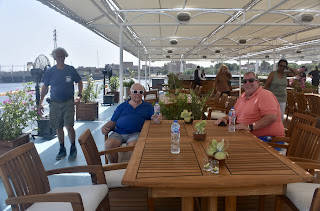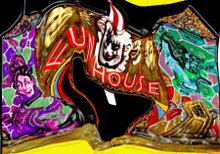Our next major archaeological site was the ptolemaic temple in Edfu. To get there we rode in horse drawn buggies, that took us down the street to a huge buggy parking area in front of the temple complex. We were in the buggy below. Our horse Samar was underfed and so thin that I felt guilty riding in his cart.
The drivers were eager to show how fast their horses were and this also made me a bit uncomfortable as they whipped the horses to speed them past other drivers.
Our driver's name was Mustafa.
His buggy was a bit decrepit. Other buggies had tassels and decorations. Ours had strings hanging down where there probably used to be tassels, but it was a pretty blue color.
The parking area was huge and we had to thread our way through rows and rows of horse parking areas and stalls to get to the entrance of the temple.
The temple at Edfu was built roughly between 237 and 57 BCE and is large and relatively in tact.
The first pylon resembles the ones we had been visiting.
This temple is devoted to Horus and was built near an earlier temple to Horus from the New Kingdom. The pylon below was begun by Ptolemy IX Soter, but not finished by him, for it depicts Ptolemy XII punishing his enemies (holding them by the hair and smiting them as we have seen on other pylons.)
As you can see the Mammisi was on the left. outside the temple.
This Mammisi had a major influence on British architecture.
This
flax mill in Leeds called Temple Works (photographed by Sarah Grice) was modeled on the Edfu temple.
I don't have much information on this temple unfortunately, so the pictures may have to speak for themselves.
The tops of the columns have the figure of Bes (the household god).
There were droves of Italian tourists at this temple, which could have been fun in and of itself, but so many of them were a bit pushy and put their hands all over the artifacts. It bothered me that they would think so little of the possible impact of their behavior on what future generations would get to see.
There were many dogs near the temple and I got great gratitude from them when I fed them.
Spousal Unit D is very fond of taking shots using Dutch angles.
The temple at Edfu is the second largest temple we have from ancient Egypt.
The inner court has an open peristyle hall .
The three sides of the court yard have a total of 32 columns.
What follows is then a hypostyle with a roof (and undecorated ceiling) built by Ptolemy VII Neo Philopator. It is followed by an inner hypostyle with a decorated ceiling also known as the festival hall.

The interior panels tell the story of the creation of the world. (None of the following images are specifically related to the story I describe as far as I can tell, but they are certainly a part of the story in some way or another.)
The story relates that the world was once covered in water and there was a struggle between water and land.
Land manages to come up close to the surface and the falcon comes and helps to plant reeds and then land is strengthened by the gods. The reeds were the source of the beginning of the Temple of Edfu, where Horus lands as a falcon.
With Ptah in the form of a harpoon, the evil Apophis is defeated and the first temple at Edfu is designed by Thoth (the god of wisdom) and Sheshat the female god of writing (and later science).
The falcon then creates the sky by reaching his wings from one side of the horizon to the other.
This allows the sun to travel through the sky.
Below we see Horus accompanied by Seshat, the goddess of writing and science. She has a seven petaled flower on her head (often with a pair of feathers on top of that). Perhaps that is Osiris on the left.
In the next panel we see Hathor leading the ptolemaic king (wearing the double crown of the two parts of Egypt) to Horus.
The ceiling of the decorated ceiling hypostyle is very dark and in need of cleaning.
...but you can discern the vulture figures on the ceiling that we have seen in other ptolemaic temples.
After the inner hypostyle comes the Hall of Offerings that then leads to the Sanctuary.
A statue of Horus was often taken out of and into the sanctuary for ceremonial purposes. Inside is an offering table and the sacred barque of Horus.
Below is the east side of the temple complex. Outside of the temple is an area that looks like a stairway.
Even though it looks like a flight of stairs (and is in fact one that leads down to an open door to the Nile), it is a actually Nilometer, a means of measuring how high the river has risen during flooding. I forgot to take a picture of it, but Warren LeMay has a shot of it in the Wikicommons.
Below you can see a few reliefs outside of the temple. I thought these were particularly attractive.
This seems to be Hathor (although she also wears the double feathers often seen on Matt).
Here you can see the side wall of the temple on the west.
There are lots of other little temples and ruins of temples on the grounds.
As we left, we had to pass through the market area.
Then we had to go back to the horse parking lot. You can only see a small portion of the stalls here and we had to find the same buggy that had taken us to the temple.
Eventually we found number 60 and were off again, passing by village shops and bakeries.
This could easily have been a very pleasant experience, but cultural differences made it less enjoyable.
I simply wasn't comfortable with the way our driver handled his horse and he would have gotten a larger tip from us (and from most foreigners) if he had been less demanding at the end of the ride.
There is a little fair in the background of this shot!
Our guide had told us what to pay the buggy driver and that regardless of what they are paid, they always complain about their tips. Mustafa was as surly as could be expected. It was a sad ending to the ride.
Back at the ship we had another great meal for lunch.
The ship launched while we ate, so that we could make our way back to Luxor.
After lunch we had to pass through the lock again.
Inside the lock the water level changed so we could head farther down the Nile.
We all climbed up to the top of the ship to watch the lock in action.
It was a festive occasion, but also a little sad, because it was one of the last things we would do before leaving the ship on the morrow.
I'm glad we got another chance to enjoy the upper deck of the ship.
We could lie back and relax and get our last glimpse of the life on the Nile.
We waved to others relaxing on the river.
Here are some chickens I saw on the banks of the river.
And isn't this a romantic shot?
It was weird seeing this ship that had turned over. (We are looking at the bottom.)
The staff of the ship greeted us for a farewell evening.
They did a marvelous job of taking care of us!
We met in the lounge for our farewells.
and then had our last dinner on board.
This was a lovely Arabic dessert. We had one last night on the Nile, but more adventures awaited us on land. We still had to see the royal mummies!

































.jpg)

































No comments:
Post a Comment